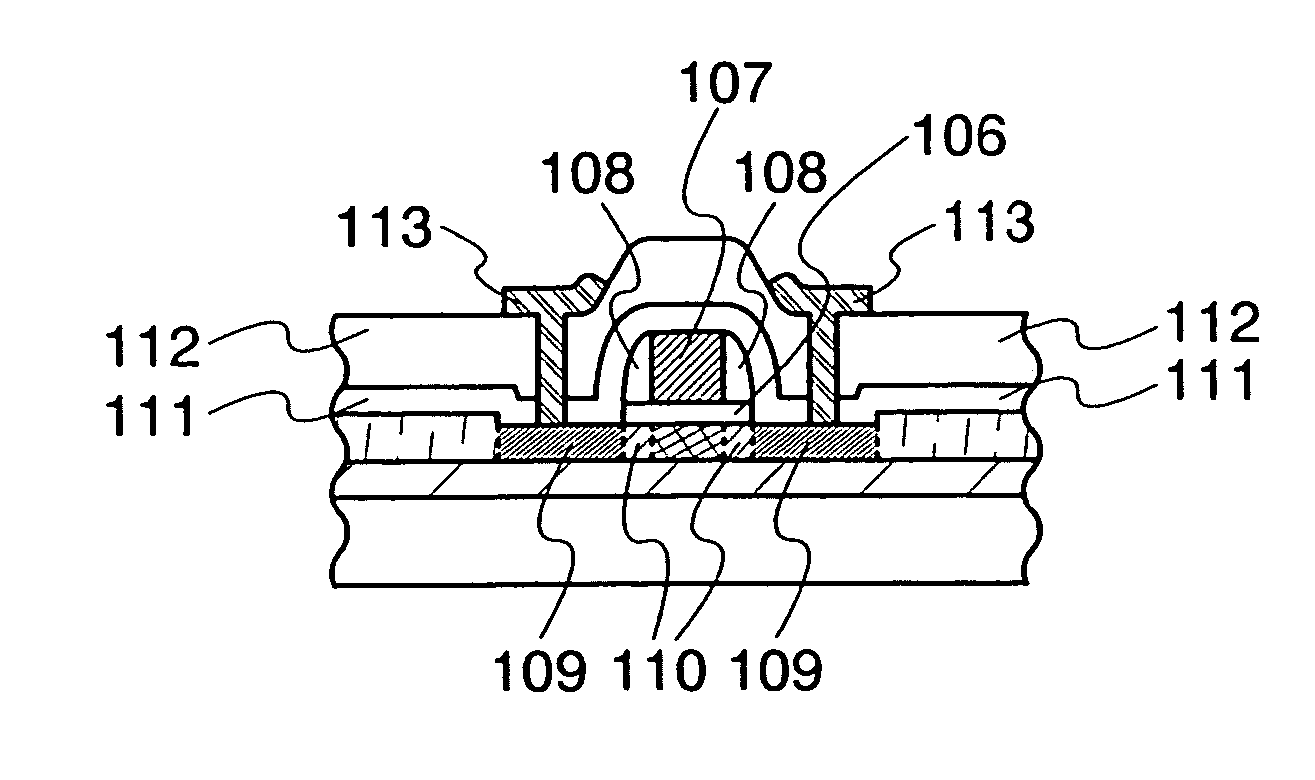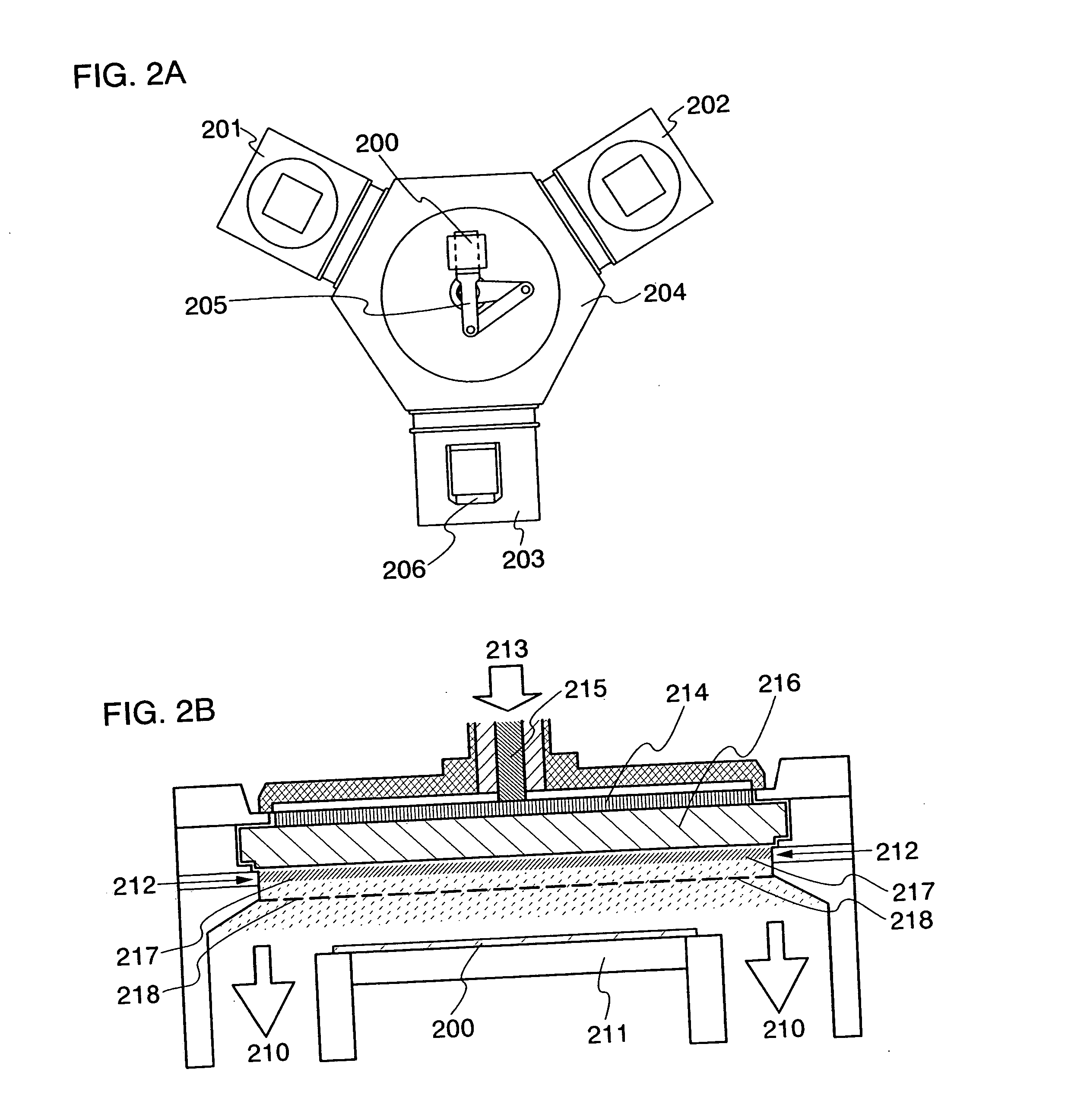Semiconductor element and method for manufacturing the same
- Summary
- Abstract
- Description
- Claims
- Application Information
AI Technical Summary
Benefits of technology
Problems solved by technology
Method used
Image
Examples
embodiment mode 1
[0039] As shown in FIG. 1A, a base film 102 is formed over a glass substrate 101. A heat-resistant plastic substrate can be used instead of the glass substrate. Other substrates may also be used as long as the substrates can withstand a temperature greater than or equal to 200° C. during plasma treatment. The base film 102 can be one-layer or multilayer. In this embodiment mode, a silicon nitride film and a SiOxNy film (x, y>0) thereover are formed continuously by a CVD method or the like. A silicon nitride film containing oxygen may be used as a silicon nitride film in order to increase adhesion with the glass substrate 101 or the like. Hereinafter, as in a silicon nitride film described in this specification, the silicon nitride film may contain oxygen.
[0040] The base film 102 is formed in order to prevent an impurity from dispersing from the glass substrate 101 into a semiconductor film which is formed later. Therefore, because a silicon oxide film is not enough to achieve this ...
embodiment mode 2
[0074] Also in this embodiment mode, element isolation is performed on a semiconductor film by plasma treatment with the use of the high-density plasma treatment apparatus as shown in FIGS. 2A and 2B. One difference with Embodiment Mode 1 is that a film preventing oxidation of the semiconductor film is used as a gate electrode without being removed.
[0075] A process of forming a base film 302 over a glass substrate 301 and forming a semiconductor film 303 thereover is the same as the process of Embodiment Mode 1 (see FIG. 3A). In addition, also in this embodiment mode, a heat-resistant plastic substrate can be used instead of the glass substrate. Other substrates may also be used as long as the substrates can withstand a temperature greater than or equal to 200° C. during plasma treatment.
[0076] Radical oxidation or radical nitridation shown in Embodiment Mode 1 is performed on the semiconductor film 303, thereby forming a gate insulating film 304. At this time, the gate insulating...
embodiment mode 3
[0082] Also in this embodiment mode, element isolation is performed by plasma treatment on a semiconductor film with the use of the high-density plasma treatment apparatus as shown in FIGS. 2A and 2B. One difference with Embodiment Mode 1 is that a film preventing oxidation of the semiconductor film is formed of an insulating film and the oxidation preventing film is used as a gate insulating film without being removed.
[0083] A process of forming the base film 402 over the glass substrate 401 and forming the semiconductor film 403 thereover is the same as in Embodiment Mode 1 (see FIG. 4A). In addition, also in this embodiment mode, a heat-resistant plastic substrate can be used instead of the glass substrate. Other substrates may also be used as long as the substrates can withstand a temperature greater than or equal to 200° C. during plasma treatment.
[0084] A film 404 preventing oxidation of the semiconductor film is formed over the semiconductor film 403 (see FIG. 4B). In this ...
PUM
 Login to View More
Login to View More Abstract
Description
Claims
Application Information
 Login to View More
Login to View More - R&D
- Intellectual Property
- Life Sciences
- Materials
- Tech Scout
- Unparalleled Data Quality
- Higher Quality Content
- 60% Fewer Hallucinations
Browse by: Latest US Patents, China's latest patents, Technical Efficacy Thesaurus, Application Domain, Technology Topic, Popular Technical Reports.
© 2025 PatSnap. All rights reserved.Legal|Privacy policy|Modern Slavery Act Transparency Statement|Sitemap|About US| Contact US: help@patsnap.com



